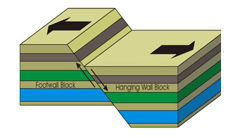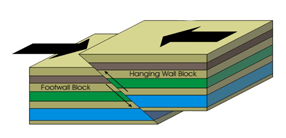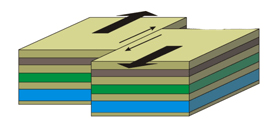What do we call the movement of the ground that occurs when rocks inside Earth pass their elastic limit, break suddenly, and experience elastic rebound?
Earthquakes (p.210)
What type of fault forms when rocks are pulled apart under tension forces?

Normal faults (p.211)
Along a normal fault, rock above the fault moves down compared to rock below the fault.
What type of wave travels fastest through rock material by causing particles in the rock to move back and forth, or vibrate, in the same direction as the waves are moving?
Primary waves, or P-waves (p.213)
What is the name of the instrument that scientists use to obtain a record of seismic waves from all over the world?
A seismograph (p.213)
What do we call a cone-shaped mountain that forms when hot magma, solids, and gas erupt onto Earth's surface through a vent?
What do we call the long cracks that form between divergent plates boundaries as they move apart?
Rifts (p.227)
Rifts contain fractures that serve as passageways for magma originating in the mantle.
Rift zones account for most of the places where lava flows onto Earth's surface.
Fissure eruptions often occur along rift zones. These eruptions form lava that cools and solidifies into basalt, the most abundant type of rock in Earth's crust.
What do we call a long crack, fracture, or fissure, that occurs when rocks break, and that results in relative movement of opposing sides?
A fault (p.211)
What type of fault forms as a result of compression forces squeezing rocks together?

Reverse faults (p.211)
Compression may cause the rock above a fault to move up compared to rock below the fault.
What type of seismic wave move through rock material by causing particles in the rock to vibrate at right-angles (or perpendicular) to the direction in which the waves are moving?
Secondary waves, or S-waves (p.213)
What is the measure of the energy released by an earthquake called?
The earthquake's magnitude (p.213)
On a seismograph, the magnitude of an earthquake is shown by the height of the lines traced that records the vibrations.
What do we call magma that has flowed onto Earth's surface?
Lava (p.219)
Some explosive eruptions throw lava and rock thousands of meters into the air. Bits of rock or solidified lava that drops from the air after a volcanic eruption are called tephra. Tephra varies in size from volcanic ash to cinders to larger rocks called bombs or blocks.
What do we call hot, molten rock material that has been forced upward from deep inside Earth, which may cause magma to break through Earth's mantle and crust and may form volcanoes?
Hot spots (p.228)
The Hawaiian volcanic islands did not form along a plate boundary. In fact, they are located well within the Pacific Plate. They have formed, and continue to form, as the Pacific Plate moves over a hot spot.
What do we call the point where a rock (or stick) can bend before breaking? At this point, if pressure is released, it will "spring back."
Its elastic limit (p.210)
What type of fault occurs when rock experiences shear forces and breaks?

Strike-slip fault (p.211)
Shear forces cause rock on either side of the strike-slip fault to move past one another in opposite directions along Earth's surface.
What type of wave is the slowest and largest of the seismic waves?
Surface waves (p.213)
What is the measure of the amount of structural and geologic damage done by an earthquake in a specific location?
The intensity of the earthquake (p.215)
Why is silica-rich magma explosive?
NOTE: silica is a compound consisting of silicon and oxygen
Sticky, thick, silica-rich magma tends to trap water vapor and other gasses. Superheated steam produces tremendous pressure in silica-thick magma. After enough pressure builds up, an eruption occurs. (p.221)
Lava containing more iron and magnesium, and less silica, tends to flow easily. Silica-rich magma tends to be thicker and more resistant to flow.
Volcanoes on Earth usually form in which three places?
Along rift zones, subduction zones (where one plate sinks beneath another), or over hot spots (p.228)
At each of these locations, magma from deep within Earth is forced upward toward the surface. Lava breaks through and flows out, where it piles up into layers or forms a volcanic cone.
What do we call the vibrations, or waves, that are transmitted through materials in Earth and on Earth's surface during earthquakes?
Seismic waves are earthquake waves (p.212)
At what type of tectonic plate boundary would you find a normal fault line?
Divergent plate boundaries
What two types of waves travel through Earth's interior?
P-waves and S-waves (p.213)
What do we call the ability of structures to stand up against the vibrations caused by an earthquake?
Seismic safe (p.217)
What type of volcano is large and broad, with gently sloping sides, that is formed by the buildup of basaltic layers?
Shield volcanoes are the largest type of volcano. They form where magma is being forced up from extreme depths within Earth, or in areas where Earth's plates are moving apart.
In which three places do earthquakes often occur?
What do we call the point inside Earth where seismic waves first occur and energy is released?
The focus of the earthquake (p.212)
After they are produced at the focus, seismic waves travel away from the focus in all directions.
At which tectonic plate boundary would you find a strike-slip fault line?
Transform plate boundaries
Which type of wave causes the most destruction during an earthquake?
Surface waves (p.213)
What is the name of the scale that is used to measure an earthquake's magnitude?
The Richter Scale (p.214)
For each increase of 1.0 on the Richter scale, the amplitude of the highest recorded seismic wave increases by 10.
What type of volcano is relatively small, and formed by moderate to explosive eruptions of tephra?
Cinder cone volcano (p.222)
Cinder cone volcanoes are usually less than 300m in height, and often form in groups near other larger volcanoes.
True or false?
Seismic waves generated by earthquakes allow researchers to figure out the structure and composition of Earth's layers.
True! (p.230)
The way that seismic waves pass through a material depends on the properties of that material. Seismic wave speeds, and how they travel through different levels of the interior, have allowed scientists to map out the major layers of Earth.
What do we call the point on Earth's surface that is located directly above the earthquake focus?
The epicenter of the earthquake (p.212)
At what type of tectonic plate boundary would you find a reverse fault line?
Convergent plate boundaries
What do we call a powerful seismic sea wave that begins over an ocean-floor earthquake?
A tsunami (p.215)
Tsunamis can reach 30m in height when approaching land, and can cause destruction in coastal areas.
What is the name of the scale that measures the intensity of an earthquake?
The Mercalli scale (p.215)
What type of volcano is steep-sided, and composed of alternating layers of lava and tephra?
Composite volcanoes (p.223)
They sometimes erupt violently, releasing large quantities of ash and gas. This forms a tephra layer of solid materials. Then a quieter eruption forms a lava layer.
What is one hypothesis for where the energy comes from to power the movement of Earth's plates?
Convection currents inside Earth provide the mechanism for plate motion, which then produces the conditions that cause volcanoes and earthquakes (p.231)
Mantle material deep inside Earth is heated by Earth's core. This hot, less dense rock material is forced toward the surface. The hotter, rising mantle material eventually cools, and then sinks into the mantle towards Earth's core, completing the convection current.